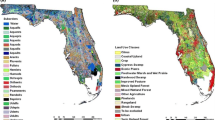Abstract
A statistical method for estimating rates of soil development in a given region based on calibration from a series of dated soils is used to estimate ages of soils in the same region that are not dated directly. The method is designed specifically to account for sampling procedures and uncertainties that are inherent in soil studies. Soil variation and measurement error, uncertainties in calibration dates and their relation to the age of the soil, and the limited number of dated soils are all considered. Maximum likelihood (ML) is employed to estimate a parametric linear calibration curve, relating soil development to time or age on suitably transformed scales. Soil variation on a geomorphic surface of a certain age is characterized by replicate sampling of soils on each surface; such variation is assumed to have a Gaussian distribution. The age of a geomorphic surface is described by older and younger bounds. This technique allows age uncertainty to be characterized by either a Gaussian distribution or by a triangular distribution using minimum, best-estimate, and maximum ages. The calibration curve is taken to be linear after suitable (in certain cases logarithmic) transformations, if required, of the soil parameter and age variables. Soil variability, measurement error, and departures from linearity are described in a combined fashion using Gaussian distributions with variances particular to each sampled geomorphic surface and the number of sample replicates. Uncertainty in age of a geomorphic surface used for calibration is described using three parameters by one of two methods. In the first method, upper and lower ages are specified together with a coverage probability; this specification is converted to a Gaussian distribution with the appropriate mean and variance. In the second method, “absolute” older and younger ages are specified together with a most probable age; this specification is converted to an asymmetric triangular distribution with mode at the most probable age. The statistical variability of the ML-estimated calibration curve is assessed by a Monte Carlo method in which simulated data sets repeatedly are drawn from the distributional specification; calibration parameters are reestimated for each such simulation in order to assess their statistical variability. Several examples are used for illustration. The age of undated soils in a related setting may be estimated from the soil data using the fitted calibration curve. A second simulation to assess age estimate variability is described and applied to the examples.
Similar content being viewed by others
References
Birkeland, P. W., 1984, Soils and Geomorphology: Oxford University Press, New York, 372 p.
Edmonds, W. J., Campbell, J. B., and Lentner, M., 1985, Taxonomic Variation Within Three Soil Mapping Units in Virginia: Soil Sci. Soc. Amer. J., v. 49, p. 394–401.
Harden, J. W., 1982, A Quantitative Index of Soil Development from Field Descriptions: Example from a Chronosequence in Central California: Geoderma, v. 18, p. 1–28.
Harden, J. W., 1987, Soils Developed in Granitic Alluvium near Merced, Ca,in J. W. Harden (Ed.), A Series of Soil Chronosequences in the Western United States: U.S. Geological Survey Bulletin 1590-A, 65 p.
Jenny, Hans, 1941, Factors of Soil Formation: McGraw-Hill, New York, 281 p.
Author information
Authors and Affiliations
Rights and permissions
About this article
Cite this article
Switzer, P., Harden, J.W. & Mark, R.K. A statistical method for estimating rates of soil development and ages of geologic deposits: A design for soil-chronosequence studies. Math Geol 20, 49–61 (1988). https://doi.org/10.1007/BF00903188
Received:
Accepted:
Issue Date:
DOI: https://doi.org/10.1007/BF00903188




